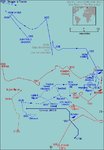delcyros
Tech Sergeant
Thanks for Your inputs, wavelength and welcome on board.
I may add that the armoured weatherdeck received a slightly different chemical treatment than the lower ballistic armoured deck in SCHARNHORST, BISMARCK-; and HINDENBURG-class ships. According to post war shooting trials carried out by the british on captured plates from TIRPITZ, the BHN level was about 10% higher for the 50mm thick plates. This had benefitting effects against cruiser fire but also helped to decap enemy projectile caps under difficult conditions. Scaling effects caused by these hard plates prevented the utiliztion of 250 BHN+ plates for the main armour deck. While homogenious, the KM was reluctant to use these treatment for any plates over 50mm thickness, when toughness becomes a more important aspect than hardness.
I think that thickness of the plates generally has a lot to do with plate resistence. The germans, italiens and british were reluctant to use 360mm+ plates for any shipboard application. The japanese and americans were not but their plates suffer from poor scaling effects.
best regards,
I may add that the armoured weatherdeck received a slightly different chemical treatment than the lower ballistic armoured deck in SCHARNHORST, BISMARCK-; and HINDENBURG-class ships. According to post war shooting trials carried out by the british on captured plates from TIRPITZ, the BHN level was about 10% higher for the 50mm thick plates. This had benefitting effects against cruiser fire but also helped to decap enemy projectile caps under difficult conditions. Scaling effects caused by these hard plates prevented the utiliztion of 250 BHN+ plates for the main armour deck. While homogenious, the KM was reluctant to use these treatment for any plates over 50mm thickness, when toughness becomes a more important aspect than hardness.
I think that thickness of the plates generally has a lot to do with plate resistence. The germans, italiens and british were reluctant to use 360mm+ plates for any shipboard application. The japanese and americans were not but their plates suffer from poor scaling effects.
best regards,

